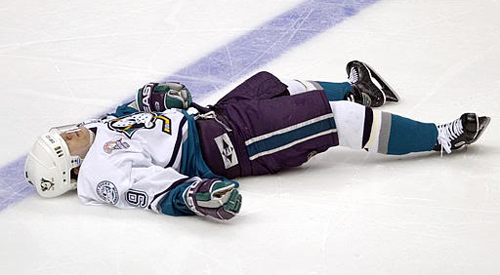
Scott Stevens on Paul Kariya revisited
The date is June 7, 2003. The New Jersey Devils and Anaheim Mighty Ducks are duelling in Game 6 of the Stanley Cup Finals. The previous five games were won by the home team, setting up a pivotal game in Anaheim where the Ducks looked to send the series back to Jersey tied at three.
With his team leading 3-1 midway through the middle period, captain Paul Kariya finds the puck between his legs in the neutral zone off a Devils turnover. He quickly corrals it at his feet and sends a pass to winger Petr Sykora. For the next second, watching his pass, Kariya contemplates where to go next, but it’s too long.
Mid-stride as he pursues the offensive zone, New Jersey defenseman Scott Stevens tracks him down, punishing the 180-pound forward with a body check. The assault leaves Kariya motionless, the ever-haunting picture of a body with arms locked in place from the effects of major head trauma.
Fast forward eight years to June 6, 2011. The NHL is in the midst of Game 3 of the Stanley Cup Finals between the Vancouver Canucks and Boston Bruins. The previous two games were won by the home team, setting up a pivotal game in Boston where the Bruins looked to send the series back to Vancouver tied at two.
With 14:58 left to go in the first period, Bruin Nathan Horton has the puck on his stick in the neutral zone and sends a pass to winger Milan Lucic. For the next second and a half, Horton looks at where the pass is going, most likely to decide where to go next. With 14:56 left to go in the period, after Horton had taken almost two full strides, Vancouver defensemen Aaron Rome slams Horton with a punishing body check. The collision leaves Horton motionless, the ever-haunting picture of a body with arms locked in place.
The stories are eerily similar. The conclusions, however, are polar opposites.
[php snippet=1]
Paul Kariya returned to the game, scored a goal and was named the game’s first star. Stevens didn’t receive a penalty nor any disciplinary action by the league. At the time, many even put onus on Kariya as much as Stevens for not keeping his head up and being aware of Stevens’ presence.
Horton on the other hand, has been ruled out for the remainder of the 2011 playoffs with a severe concussion while Rome received a major penalty and a game misconduct along with a four-game suspension, ensuring he will not play for the rest of the Finals. Horton has received little criticism for not being aware of his surroundings while Rome has been greatly blamed for attacking a defenseless player.
In both of these instances, most of the general public seems to think that the outcome was expected. The interesting similarity about the two situations is that they’re perfect examples of current societal values in relation to sport. Athletes are being treated more like humans than the immortal gladiators they were previously perceived as.
It’s an absolute necessity for today’s athlete. The combination of increased speed and more safety equipment that can be used — both purposefully or accidentally — as a weapon, have made high contact sports like hockey more dangerous than ever.
An athlete’s body, no matter in what pristine physical shape, can only take so much. These two factors aren’t likely to change any time soon. With the development of training systems and nutrition regimens, athletes aren’t getting any slower either.
The only thing left to do then is to change the rules to protect the players. Regardless of the reflexive public outcry.
In 2003, a hit like the one Stevens threw Kariya’s way was legal. In 1997, you could see Craig MacTavish play without a helmet. In 1979, you could see Gump Worsley mind the net without a mask. Unfortunately, injury or tragedy preceded these changes.
In 1959, Jacques Plante wore a mask to protect his broken nose which had been broken by taking a shot to the face. In 1968, a helmetless Bill Masterson was killed after a body check sent him to the ice head first, resulting in the first and only NHL player killed by an on-ice play.
Nowadays, masks and helmets are seen as an absolute for the sport although back then they were met with great resistance. Although no one can predict the future, a change is inevitable in regards to checking in the NHL and with it the thought that it will create a sharp decline to serious head injuries.
After that change, one can only hope that 25 years from now the hockey community will wonder how they ever played it any other way.
[php snippet=1]

